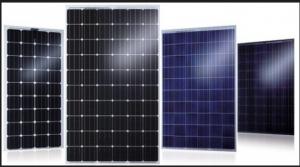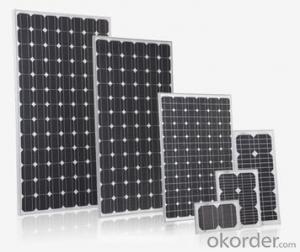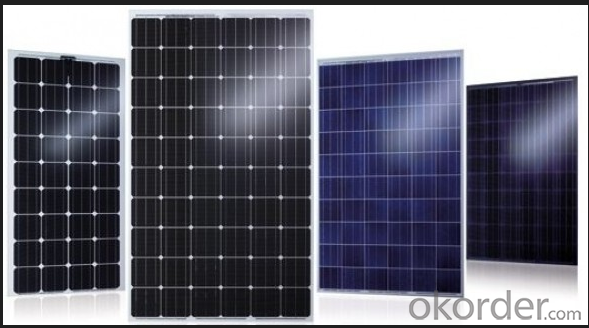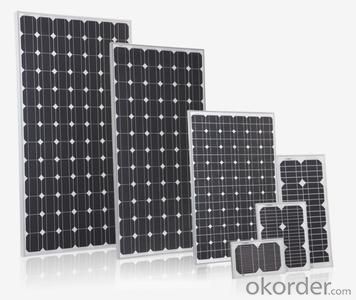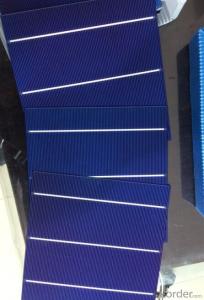Silicon Solar Cell 156mm*156mm with Different Efficiency
- Loading Port:
- China main port
- Payment Terms:
- TT or LC
- Min Order Qty:
- 100 m.t.
- Supply Capability:
- 10000000 m.t./month
OKorder Service Pledge
OKorder Financial Service
You Might Also Like
Description:
CNBM Solar is a world-leading and Vertical integrated manufacturer of high-performance with Silicon,
Wafer, Cells, Modules, which convert sunlight into electricity for residential, commercial, and utility-scale
power generation.
The capacity of CNBMSolar is reach to 1GW, and make sure each year our shipment capacity is more
Than 700-800MWs, at the same time, we have set up the largest solar power station with our partner
in Ukraine.
CNBM is a Quality + Service oriented company with“Excellence at Each Step” approach, composed of
the finest components from TUV and IEC-certified partners around the world, CNBM modules consistently
undergo a variety of trials at the company’s Test & Development Centre, ensuring peak performance
capabilities. The company is committed to develop and provide the world with clean and renewable energy
to ease the energy shortages as well as human kind’s impact on the environment.
Packaging & Delivery
| Packaging Detail: | Typical package for one carton contains 1,200 cells.The cells are sealed in cell box every 100pcs.Gross weight peri unit carton shall be around 17.1Kg. |
| Delivery Detail: | Within 1-2days after received payment |
Specifications
*High efficiency and High power
*Long-term electrical stability
*Best quality
*fast ship
156mm Multi-Crystalline Silicon Solar Cell low price, high efficiency for solar panels/ modules
PHYSICAL
Dimension: 156mm x 156mm ± 0.5mm
TYPICAL ELECTRICAL CHARACTERISTICS
| Efficiency | 1640 | 1660 | 1680 | 1700 | 1720 | 1740 | 1760 |
| Efficiency(min)% | 16.4 | 16.6 | 16.8 | 17.0 | 17.2 | 17.4 | 17.6 |
| Pmax(W) | 3.991 | 4.040 | 4.088 | 4.137 | 4.186 | 4.234 | 4.283 |
| Voc(V) | 0.623 | 0.626 | 0.629 | 0.631 | 0.633 | 0.635 | 0.637 |
| Isc(A) | 8.412 | 8.455 | 8.506 | 8.557 | 8.602 | 8.643 | 8.681 |
| Vmp(v) | 0.515 | 0.517 | 0.520 | 0.522 | 0.524 | 0.526 | 0.527 |
| Imp(A) | 7.750 | 7.814 | 7.862 | 7.926 | 7.988 | 8.050 | 8.127 |
*Data under standard testing conditional (STC):1,000w/m2,AM1.5, 25°C , Pmax:Positive power tolerance.
TYPICAL TEMPERATURE Voltage -2.14 mV/K
COEFFICIENTS Current +4.93 mA/K
Power -0.43 %/K
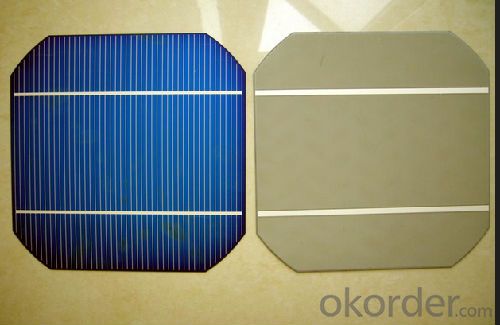
FAQ:How to PACK?
Typical package for one carton contains 1,200 cells.The cells are sealed in cell box every 100pcs.Gross weight peri unit carton shall be around 17.1Kg.
- Q:Can solar cells be used in agriculture for irrigation?
- Yes, solar cells can be used in agriculture for irrigation. Solar-powered water pumps can be used to draw water from wells or other sources, providing a reliable and sustainable solution for irrigation. This helps farmers reduce their dependence on traditional energy sources and decrease operational costs, making solar cells a viable option for agricultural irrigation.
- Q:My solar cells are broken, can I just buy one and replace it?
- No, you just can not do properly
- Q:Can solar cells be used in agricultural settings?
- Yes, solar cells can be used in agricultural settings. They can be used to power various agricultural equipment such as irrigation systems, electric fences, and lighting. Solar cells can also be used to generate electricity for on-site use or for feeding back into the grid, reducing energy costs and promoting sustainability in agricultural practices. Additionally, solar cells can be integrated into greenhouse structures to provide power for ventilation, heating, and cooling systems, creating a more energy-efficient and environmentally friendly agricultural environment.
- Q:Can solar cells be used in space heating systems?
- Yes, solar cells can be used in space heating systems. Solar panels, which consist of solar cells, can convert sunlight into electricity. This electricity can then be used to power space heating systems, either directly or through storage in batteries. Additionally, solar thermal systems can use solar energy to heat water or air, which can then be used for space heating purposes.
- Q:What is a solar cell?
- A solar cell, also known as a photovoltaic cell, is a device that converts sunlight directly into electricity. It is made up of semiconductor materials that absorb photons from sunlight, creating an electric current. Solar cells are used in solar panels to generate renewable energy for various applications, such as powering homes and businesses.
- Q:What diode does the solar panel use?
- It is necessary to allow the light after the effect of electricity into the battery and must prevent the operation of the PV components due to partial damage.
- Q:Are solar cells affected by shade?
- Yes, solar cells are affected by shade. Shade can significantly reduce the efficiency and output of solar cells. When solar cells are shaded, they receive less sunlight, which reduces the amount of energy they can convert into electricity. Therefore, it is important to ensure that solar panels are installed in a location where they receive maximum sunlight exposure throughout the day for optimal performance.
- Q:Can solar cells be used in powering autonomous vehicles?
- Yes, solar cells can be used in powering autonomous vehicles. Solar panels can be installed on the surface of the vehicle to capture sunlight and convert it into electricity. This renewable energy source can supplement or even replace traditional fuel sources, making autonomous vehicles more sustainable and reducing their carbon footprint.
- Q:Are there any subsidies or incentives for installing solar cells?
- Yes, there are subsidies and incentives available for installing solar cells. Many governments and local authorities offer financial incentives such as tax credits, grants, and rebates to encourage the adoption of solar energy. Additionally, some utility companies provide feed-in tariffs or net metering programs, which allow solar system owners to sell excess electricity back to the grid or receive credits on their energy bills. These subsidies and incentives aim to make solar installations more affordable and promote the transition to clean and renewable energy sources.
- Q:What materials are commonly used to make solar cells?
- The most commonly used materials to make solar cells are silicon, cadmium telluride, and copper indium gallium selenide.
1. Manufacturer Overview |
|
|---|---|
| Location | |
| Year Established | |
| Annual Output Value | |
| Main Markets | |
| Company Certifications | |
2. Manufacturer Certificates |
|
|---|---|
| a) Certification Name | |
| Range | |
| Reference | |
| Validity Period | |
3. Manufacturer Capability |
|
|---|---|
| a)Trade Capacity | |
| Nearest Port | |
| Export Percentage | |
| No.of Employees in Trade Department | |
| Language Spoken: | |
| b)Factory Information | |
| Factory Size: | |
| No. of Production Lines | |
| Contract Manufacturing | |
| Product Price Range | |
Send your message to us
Silicon Solar Cell 156mm*156mm with Different Efficiency
- Loading Port:
- China main port
- Payment Terms:
- TT or LC
- Min Order Qty:
- 100 m.t.
- Supply Capability:
- 10000000 m.t./month
OKorder Service Pledge
OKorder Financial Service
Similar products
New products
Hot products
Hot Searches
Related keywords
